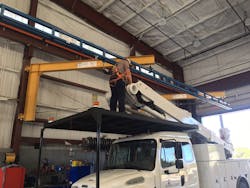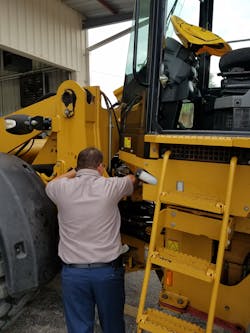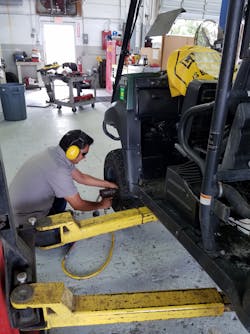How to keep equipment shops safe
In an equipment shop, risk runs rampant on a day-to-day basis. The moment a technician isn’t remaining cognizant of training they’ve undergone, accidents manifest in unexpected ways. From falls and crushing injuries to burns and toxin inhalation, the dangers within a shop are wide ranging but, for the most part, preventable.
Although these hazards pose a sizable risk, Carl Uhinck, an equipment manager at Kokosing Construction, says the most dangerous situation in an equipment shop is working in teams. When several people are working together on the same task, the communication needed to effectively work needs to be clear and fluid, with no room for error.
“Oftentimes it comes down to, ‘I thought the other person was going to do this, so I did this,’ and then we have a pinched finger or what have you,” he says.
Communication plays a key part in completing jobs safely and effectively. Shop teams talk regularly about safety precautions and best practices, with most conversations happening on a daily basis.
Uhinck said his workers engage in action plan meetings every morning.
“Any time we’re working in teams, we have a conversation about who the team leader is of this repair, and what kind of communication we’re going to have,” he says.
Afterward, workers discuss the tasks that will be performed for the day, and analyze how projects will be accomplished with zero high-risk behavior.
“We start talking about what we’re about to do, what the hazards are, and how we can eliminate them, and we roll out that plan,” Uhinck says. “And that’s training, that’s educating everyone involved. After identifying the at-risk hazards we face, we ask clarifying questions to make sure everyone has an understanding of the plan, and the information they just heard.”
The Kokosing team also gathers for a safety committee meeting once a month. These meetings help educate the leadership about the challenges workers are facing, what safety information is available, and what “near hits” or accidents the shop may need to review.
“We collaborate on solving problems,” Uhinck says. “That’s a really educational session, and then as we communicate with everyone in our field and shops, it’s really a good way to keep everyone on the same page when it comes to education of current safety events.”
Similarly Jon Marquez, equipment manager at RMCI, conducts safety meetings with his team on a weekly basis.
“We’re always talking about awareness, and making sure that everyone is looking out for each other,” he said. “If workers see high-risk situations, they’ll stop and make sure we’re communicating. We [also] offer a quarterly safety bonus if there are no recordable incidents.”
Craig Worrell, CEM, director of fleet operations for Davis Constructors and Mass Excavation, works with his managers to develop his shop’s safety standards.
“I take my three direct reports, and we take out a couple times a week to discuss safety and leadership for the shop and areas where we want to improve,” he says. “We then discuss these things at a safety meeting with the rest of the crew so they can share their thoughts or experiences on the matter.”
Worrell also holds shop safety meetings twice a week.
“We found this to be the most effective way to keep the shop engaged in safety training,” he says. “The topics range from safe driving habits to safely jacking up equipment. These topics mean something to the people in the organization, and that helps to keep them motivated to bring more interesting topics on there next turn to present.”
Ron Kennedy, Sarasota County (Florida) fleet manager, pairs videos alongside conversations with his team. James Dowdy, the shop’s safety compliance officer, executes the entire safety program of his division.
“Sometimes a graphic video is better than the conversation,” Kennedy says. “You know, if [a worker] was using proper fall protection, this wouldn’t have happened, or if he had his safety glasses on he could see out of both eyes.”
Fully understanding the risks involved when it comes to shop safety also helps keep workers focused. Uhinck says that although all employees are at different levels when it comes to their personal safety culture, most benefit from motivation through communication.
“I think what motivates technicians is a reminder of ‘if you get hurt, how is that going to affect you and your family?’” he says. “You know, you have kids that want you to throw the ball with. You get your hand in a line of fire situation and lose two fingers, that’s gonna really affect your life. So I think reaching out to everyone to understand what they’re going home for is really a huge motivator.”
Even with all the conversation, however, shop workers need safe spaces in which to work. Many shops have multiple bays working on different projects, so keeping the walking and working surfaces clear, along with maintaining visibility, is essential.
Chad Burdick, CEM, equipment manager of Constructors, recently installed LED lighting in his shop. He says the change has made a substantial difference for his workers.
“The better you can see, the less opportunity you have for tripping hazards,” Burdick says. “In addition to being well lit, we’re saving quite a bit of money on our electric bill as a result.”
Burdick says, overall, a clean shop is a safer shop. In addition to LEDs, his shop also boasts a well-organized tool room.
“Everything is where it needs to be, so you don’t waste time running around looking for something that you need,” he says. “If you walk in the tool room and it’s painted on the ground that this is where the floor jack went and it’s not there, then you know it’s probably out on the floor somewhere.”
Burdick says in his shop, the most dangerous area is the fabrication and welding department. Since the team doesn’t have a separate shop for welding, both sections are incorporated into the company’s main shop.
“With all the lifting and cutting and welding and sparking, that’s probably our biggest area of exposure in terms of hazard and injuries,” he says.
Last year, along with painting safety lines for walkway access, installing flammable safety cabinets, and buying a Tennant floor scrubber, Burdick also added retractable air hoses and electrical cords to the mix of tool improvements.
“We had a little trouble with the guys not rolling them up, and now there’s no excuse,” he says. “They just give it a tug, and everything gets rolled up nice and neat at the end of the day or the job.”
Worrell says failing to properly use shop tools, and the personal protective equipment associated with them, is another common risk across several equipment shops.
“Work on the press or grinder stands out among all the tools because there are possibilities for high-speed projectiles at any time during the work,” he says. “We put a blanket system on the press to assist in mitigating the dangers on this particular tool.”
Worrell said the system will catch and slow down projectiles that may fly off the parts that are being processed, or the parts themselves. When it comes to the grinder, he expects his workers to ensure all guarding and shields are in place.
Personal protection must-haves
Another danger that appears within an equipment shop is work that occurs off the floor, in an elevated space. Uhinck says although implementing fall protection is important depending on the nature of the shop, setup is difficult to execute properly.
“It’s very challenging,” he says. “There are a lot of things to consider; where’s a good tie off point? Do we have a place we can tie off into the ceiling to come down and work on our equipment? Can we use our overhead lift as a fall protection point? I think it’s very dangerous and something you really have to look at.”
Kennedy implemented a fall-protection system in Sarasota. The system is completely integrated into the building, and is used whenever technicians are working on larger equipment such as excavators, completing rooftop work on cabs, or any elevated work area. Kennedy’s system in particular has a foldaway feature, and is designed to work in tandem with a 5-ton, overhead, traversing crane.
“Whenever you have a vehicle in, and you’re going to have to climb over that 6-foot/7-foot height, one solid beam folds out from the wall, and then you hook to it and you can walk the entire length of the shop,” he says. “Then whenever you’re done with it, you fold it back into the wall structure. You’re not limited by this thing. It’s really neat.”
Another risk Kennedy has addressed is equipment that is unlocked or untagged out.
“I hold that a really high priority,” Kennedy says. “The inertia of the equipment running with the technician around it without them knowing is extremely dangerous.”
Uhinck says as the industry moves forward, managers need to make time not only to recognize teachable moments, but also to focus on when things are being done right in a shop.
“Maybe I’ve been guilty of not doing this too, but when you see something good happening, you need to recognize it,” he says. “We’re really good at recognizing when things are wrong. But when we see something going right, we more often just walk by it and say ‘they’re doing it right, that’s our expectation.’
“When I come into my shop now, I come in thinking, ‘I’m going to find something that’s right here today,’” he said. “I think recognizing and rewarding good safety habits and safety culture is a powerful motivator.”
About the Author
Gianna Annunzio
Gianna was associate editor from 2018 - 2021.


